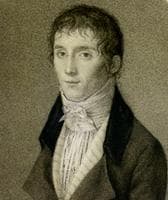Scientists hope to deliver a clearer picture of historic work pioneered by the Frenchman credited as the world?s ?first photographer? in previously unpublished research later this year.
Amateur scientist Joseph Nicéphore Niépce captured the first surviving photograph from nature around 1826.
Crucially, the Frenchman was not only able to develop the image, he was also able to fix it, having first experimented by copying drawings through the action of light – and subsequent etching – more than a decade earlier.
Niépce (pictured) is believed to have contributed to Louis Daguerre?s discovery of the light sensitivity of iodised silver plates in 1831.
Daguerre and British inventor William Henry Fox Talbot were regarded as the founding fathers of practical, or ?modern?, photography in papers they published separately in 1839.
Scientists at the Getty Conservation Institute are due to unveil the results from scientific analysis of Niepce?s experiments in a two-day conference at the National Media Museum in Bradford on 13 and 14 October.
They will focus on three photographic plates that Niépce brought to England in 1827 and say they will reveal more about their history than has previously been documented.
Getty Conservation Institute?s senior scientist Dusan Stulik told the museum: ?Our findings show a different light on the early history of photography than has been described in literature? Through scientific means we are able to see into the darkroom procedures which Niépce was using and we are trying to understand why he selected different photographic processes ? what his thinking behind the experimentation was.
?What makes the work of Niépce really special is that he was the first photographer? because he produced the first photograph still in existence that was also stabilised ? it didn?t change by exposure to light?
?So this was the first example of a successful photography process.’
Stulik added: ?What makes me very excited about this whole experience is that everything we do [today] is a product of that first photograph ? all photography, film, television, even games and 3D TV. Everything goes back to that single moment in 1826 when Niépce [pointed] his camera out of the window and took that first photograph. It was a magical moment.?
The Bradford conference also aims to address future conservation measures.







